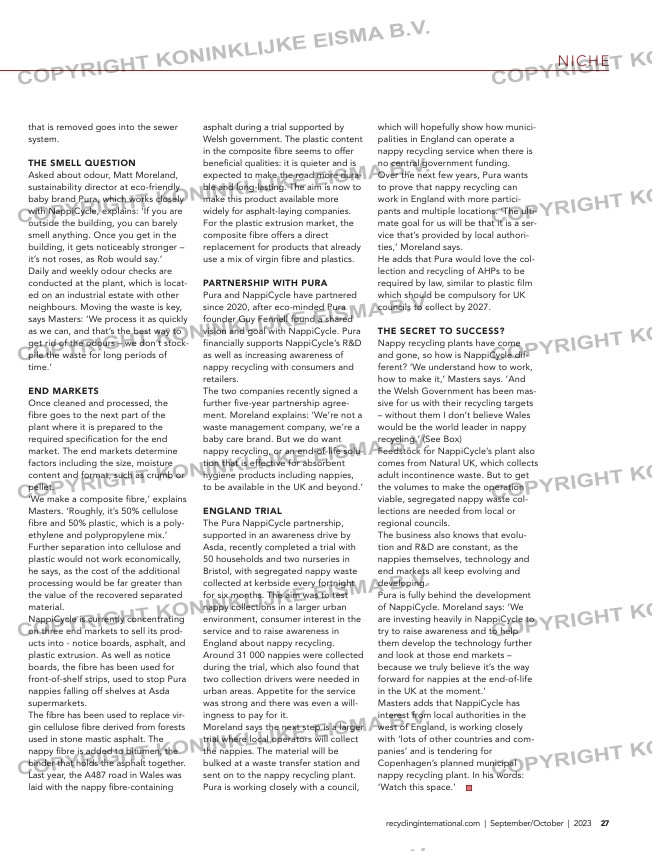Page 27 from: Recycling International – free September/October Issue

27recyclinginternational.com | September/October | 2023
NICHE
that is removed goes into the sewer
system.
THE SMELL QUESTION
Asked about odour, Matt Moreland,
sustainability director at eco-friendly
baby brand Pura, which works closely
with NappiCycle, explains: ‘If you are
outside the building, you can barely
smell anything. Once you get in the
building, it gets noticeably stronger –
it’s not roses, as Rob would say.’
Daily and weekly odour checks are
conducted at the plant, which is locat-
ed on an industrial estate with other
neighbours. Moving the waste is key,
says Masters: ‘We process it as quickly
as we can, and that’s the best way to
get rid of the odours – we don’t stock-
pile the waste for long periods of
time.’
END MARKETS
Once cleaned and processed, the
fibre goes to the next part of the
plant where it is prepared to the
required specification for the end
market. The end markets determine
factors including the size, moisture
content and format, such as crumb or
pellet.
‘We make a composite fibre,’ explains
Masters. ‘Roughly, it’s 50% cellulose
fibre and 50% plastic, which is a poly-
ethylene and polypropylene mix.’
Further separation into cellulose and
plastic would not work economically,
he says, as the cost of the additional
processing would be far greater than
the value of the recovered separated
material.
NappiCycle is currently concentrating
on three end markets to sell its prod-
ucts into – notice boards, asphalt, and
plastic extrusion. As well as notice
boards, the fibre has been used for
front-of-shelf strips, used to stop Pura
nappies falling off shelves at Asda
supermarkets.
The fibre has been used to replace vir-
gin cellulose fibre derived from forests
used in stone mastic asphalt. The
nappy fibre is added to bitumen, the
binder that holds the asphalt together.
Last year, the A487 road in Wales was
laid with the nappy fibre-containing
asphalt during a trial supported by
Welsh government. The plastic content
in the composite fibre seems to offer
beneficial qualities: it is quieter and is
expected to make the road more dura-
ble and long-lasting. The aim is now to
make this product available more
widely for asphalt-laying companies.
For the plastic extrusion market, the
composite fibre offers a direct
replacement for products that already
use a mix of virgin fibre and plastics.
PARTNERSHIP WITH PURA
Pura and NappiCycle have partnered
since 2020, after eco-minded Pura
founder Guy Fennell found a shared
vision and goal with NappiCycle. Pura
financially supports NappiCycle’s R&D
as well as increasing awareness of
nappy recycling with consumers and
retailers.
The two companies recently signed a
further five-year partnership agree-
ment. Moreland explains: ‘We’re not a
waste management company, we’re a
baby care brand. But we do want
nappy recycling, or an end-of-life solu-
tion that is effective for absorbent
hygiene products including nappies,
to be available in the UK and beyond.’
ENGLAND TRIAL
The Pura NappiCycle partnership,
supported in an awareness drive by
Asda, recently completed a trial with
50 households and two nurseries in
Bristol, with segregated nappy waste
collected at kerbside every fortnight
for six months. The aim was to test
nappy collections in a larger urban
environment, consumer interest in the
service and to raise awareness in
England about nappy recycling.
Around 31 000 nappies were collected
during the trial, which also found that
two collection drivers were needed in
urban areas. Appetite for the service
was strong and there was even a will-
ingness to pay for it.
Moreland says the next step is a larger
trial where local operators will collect
the nappies. The material will be
bulked at a waste transfer station and
sent on to the nappy recycling plant.
Pura is working closely with a council,
which will hopefully show how munici-
palities in England can operate a
nappy recycling service when there is
no central government funding.
Over the next few years, Pura wants
to prove that nappy recycling can
work in England with more partici-
pants and multiple locations. ‘The ulti-
mate goal for us will be that it is a ser-
vice that’s provided by local authori-
ties,’ Moreland says.
He adds that Pura would love the col-
lection and recycling of AHPs to be
required by law, similar to plastic film
which should be compulsory for UK
councils to collect by 2027.
THE SECRET TO SUCCESS?
Nappy recycling plants have come
and gone, so how is NappiCycle dif-
ferent? ‘We understand how to work,
how to make it,’ Masters says. ‘And
the Welsh Government has been mas-
sive for us with their recycling targets
– without them I don’t believe Wales
would be the world leader in nappy
recycling.’ (See Box)
Feedstock for NappiCycle’s plant also
comes from Natural UK, which collects
adult incontinence waste. But to get
the volumes to make the operation
viable, segregated nappy waste col-
lections are needed from local or
regional councils.
The business also knows that evolu-
tion and R&D are constant, as the
nappies themselves, technology and
end markets all keep evolving and
developing.
Pura is fully behind the development
of NappiCycle. Moreland says: ‘We
are investing heavily in NappiCycle to
try to raise awareness and to help
them develop the technology further
and look at those end markets –
because we truly believe it’s the way
forward for nappies at the end-of-life
in the UK at the moment.’
Masters adds that NappiCycle has
interest from local authorities in the
west of England, is working closely
with ‘lots of other countries and com-
panies’ and is tendering for
Copenhagen’s planned municipal
nappy recycling plant. In his words:
‘Watch this space.’
Fotobijschrift
NappiCycle’s plastic and cellulose com-
posite fibre pellets.
26-27_uknappyproject.indd 27 12-09-2023 16:09



